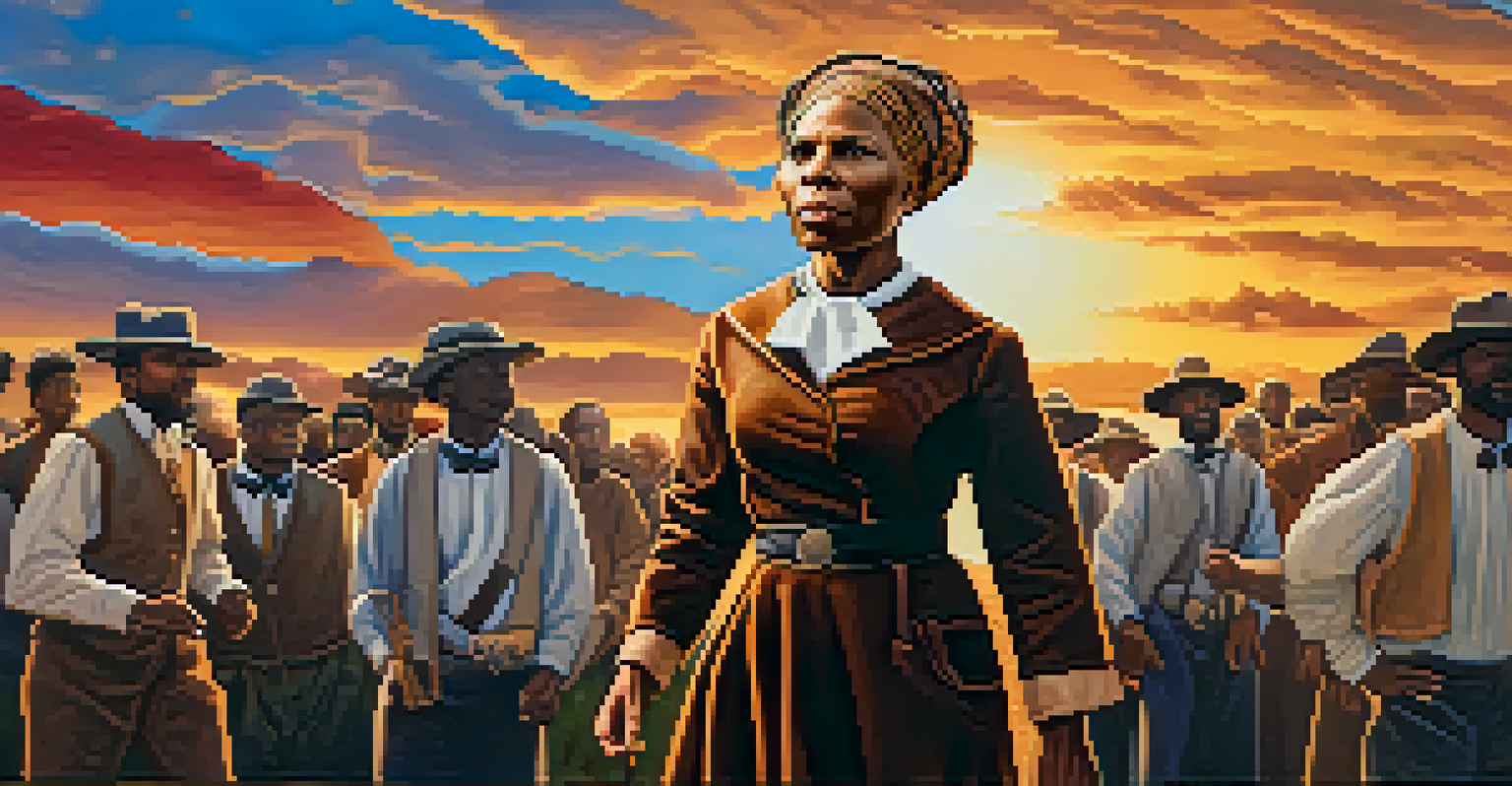The Underground Railroad: Sites That Shaped Freedom Stories

Understanding the Underground Railroad's Purpose and Impact
The Underground Railroad was not an actual railroad, but a network of secret routes and safe houses that helped enslaved people escape to freedom. This intricate system operated primarily in the 19th century, providing a lifeline for those seeking to break free from the bonds of slavery. It was a collaborative effort involving abolitionists, former enslaved people, and allies who risked their safety to aid others.
I freed a thousand slaves. I could have freed a thousand more if only they knew they were slaves.
What made the Underground Railroad remarkable was its blend of courage, community, and creativity. Enslaved individuals would often travel by night, guided by the North Star, with trusted conductors leading them to safe havens. This clever use of metaphorical 'railroad' terms helped maintain secrecy, while the commitment of those involved showcased the deep desire for freedom.
The legacy of the Underground Railroad is profound, as it not only helped countless people escape but also ignited discussions about human rights and equality that resonate today. This historical movement reminds us of the human spirit's resilience in the face of oppression.
Harriet Tubman: A Beacon of Hope and Leadership
One of the most renowned figures of the Underground Railroad is Harriet Tubman, often referred to as 'Moses' for her role in leading others to freedom. Tubman escaped slavery herself but returned to the South multiple times to guide others along the perilous route to safety. Her bravery and determination transformed her into a symbol of hope for many.

Tubman's strategies were noteworthy; she used various methods to evade capture, including disguises and coded messages. Through her efforts, she successfully led around 70 enslaved individuals to freedom, showcasing her deep commitment to the cause. Her story serves as a powerful reminder of the impact one person can have in the fight for justice.
Courageous Escape Network
The Underground Railroad was a secret network that enabled enslaved people to escape to freedom through safe routes and houses.
Tubman's legacy continues to inspire modern movements for equality and civil rights, illustrating how the fight for freedom is a timeless struggle. Her life exemplifies the courage and tenacity required to challenge injustice and uplift others.
The Role of Safe Houses in the Underground Railroad
Safe houses played a crucial role in the Underground Railroad, providing temporary refuge for escaping enslaved people. These homes were often owned by abolitionists who risked their lives to protect those seeking freedom. Each safe house operated under a code of secrecy, ensuring that the identities of its occupants remained hidden.
The time is always right to do what is right.
Many safe houses featured hidden compartments or secret rooms where individuals could hide from pursuers. The network of these homes extended across various states, allowing for a fluid movement toward the North. This safe haven not only offered physical shelter but also emotional support, as those in peril found solidarity with others sharing their plight.
The bravery of those who hosted safe houses cannot be overstated; they often faced harsh penalties if discovered. Their selflessness illustrates the power of community and collective action in the pursuit of freedom, reminding us that change often starts at the grassroots level.
Key Routes and Locations Along the Underground Railroad
The journey to freedom was fraught with danger, and understanding the key routes used in the Underground Railroad is essential. Many enslaved individuals traveled through states like Maryland, Delaware, and Pennsylvania, with the ultimate goal of reaching Northern states or Canada. Each route had its own challenges, including natural obstacles and the constant threat of capture.
Landmarks such as the Harriett Tubman Underground Railroad Visitor Center in Maryland highlight the critical pathways taken by freedom seekers. These locations serve as reminders of the courage exhibited by those who traveled these routes. Traveling these paths today allows us to connect with the past and appreciate the sacrifices made in the name of liberty.
Harriet Tubman's Leadership
Harriet Tubman, known as 'Moses,' exemplified bravery by leading numerous enslaved individuals to safety, becoming a symbol of hope.
The significance of these routes extends beyond their historical context; they symbolize the quest for freedom that continues today. By exploring these pathways, we honor the legacy of those who journeyed toward a brighter future.
The Impact of Abolitionists on the Underground Railroad
Abolitionists played a pivotal role in the success of the Underground Railroad, advocating for the end of slavery and actively participating in the escape efforts. Many were motivated by moral beliefs, while others were driven by political ambitions or personal experiences. Their contributions varied from providing safe houses to organizing escape plans.
Figures like Frederick Douglass and William Lloyd Garrison used their platforms to raise awareness about the injustices of slavery. Their writings and speeches galvanized public opinion, encouraging more people to join the cause. The collaboration between abolitionists and the freedom seekers created a powerful alliance that challenged the status quo.
Today, we remember these abolitionists not only for their activism but for the sense of community they fostered. Their collective efforts remind us that social change often requires collaboration and unwavering commitment.
The Legacy of the Underground Railroad in Modern Times
The legacy of the Underground Railroad is not confined to history books; its impact can still be felt today. The stories of courage and resilience serve as a source of inspiration for contemporary movements advocating for justice and equality. Just as the conductors of the Railroad fought for freedom, modern activists continue to challenge systemic injustices.
Educational programs and commemorative events allow us to honor the sacrifices made by those involved in the Underground Railroad. Museums and historical sites dedicated to this cause provide insight into the past, encouraging reflection on current societal issues. These initiatives foster a deeper understanding of the importance of civil rights.
Legacy of Community Action
The impact of abolitionists and safe houses during the Underground Railroad highlights the importance of community and collaboration in the fight for freedom.
By recognizing and celebrating this legacy, we keep the spirit of the Underground Railroad alive. It serves as a powerful reminder that the fight for freedom is ongoing and that each generation has a role to play in shaping a more just world.
Commemorating the Underground Railroad: Museums and Memorials
Numerous museums and memorials across the United States commemorate the Underground Railroad and its heroes. Sites like the National Underground Railroad Freedom Center in Cincinnati provide immersive experiences that educate visitors about this critical period in history. Through exhibits and personal stories, these institutions bring the past to life.
Memorials also serve as poignant reminders of the struggles endured in the pursuit of freedom. They honor the lives lost and the sacrifices made by those who fought against slavery. These spaces invite reflection and dialogue, fostering a deeper understanding of our shared history.

Visiting these museums and memorials allows individuals to connect personally with the stories of courage and resilience. By engaging with this history, we not only honor those who came before us but also commit ourselves to continuing the fight for justice.
The Importance of Education in Preserving Freedom Stories
Education plays a vital role in preserving the stories of the Underground Railroad and ensuring that future generations understand its significance. By incorporating these narratives into school curricula, we can foster a sense of empathy and awareness about the struggles for freedom. Understanding this history is essential for recognizing the ongoing fight for equality.
Programs that focus on storytelling and local history can ignite a passion for learning about the past. Engaging students in discussions about the Underground Railroad encourages critical thinking about social justice issues still relevant today. Knowledge is a powerful tool, and educating young minds about this history equips them to advocate for change.
The stories of the Underground Railroad remind us of the importance of standing up against injustice. By championing education, we ensure that the legacy of those who sought freedom remains alive and relevant, inspiring new generations to continue the fight for equality.